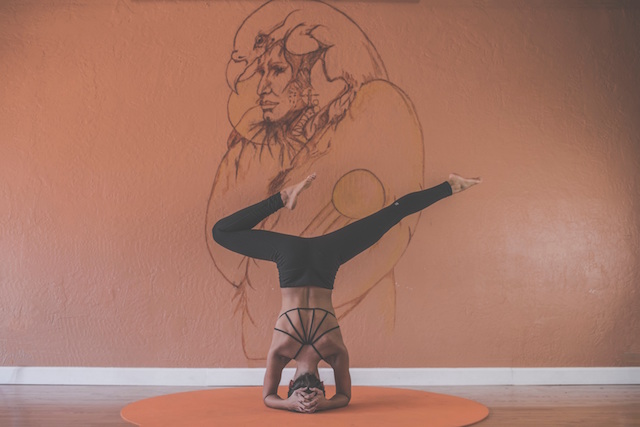
After being interviewed by new clients on a daily basis, and after hearing enough “yoga fail” stories that yoga teachers as a collective ought to be concerned, I felt compelled to write down the top 10 complaints people give me about most yoga studios.
The reasons people had never tried yoga or tried but never returned. The reasons “people like them” can’t do yoga. The reasons they felt excluded.
If you want to keep the average person out of your studio, do the following:
1. Advertise with lots of beautiful people doing impossibly beautiful poses.
There are a lot of confident people in the world, but there are even more who are not—and those folks love nothing more than a challenge. Actually, I’m kidding, they don’t. The sight of one poster in your window or on your website of an uber-lean model gracefully stretching back into Eka Pada Rajakapotasana iii, with the sole of her foot softly grazing the back of her head, and the mildly interested yoga newbies will run.
You don’t even have to read the other nine steps. That alone will scare them off.
2. Don’t offer gentle or beginners classes.
Look around at your general population of people. Not the people at your yoga studio. Go to the grocery store, the mall or the airport and look at the majority of the people you see. Really see them. Take them in and ask yourself if they could reasonably keep up with any of the classes offered at your studio.
The grandmother; the 40-year-old mom of three who hasn’t lost the baby weight and whose only activity over the last eight years are the squats she does to pick Legos and Barbie shoes off the floor; the attorney who sits at a desk behind a computer all day and hasn’t moved his body since junior high PE class; the older woman who had a hip replacement; the anxious and hesitant—I could go on…
How many of the people that you see around you would be weeded out of your class before they even tried? Think about it. Take your time, no rush.
3. Make random rules.
I had a client who came to me after checking out another more popular studio in town. He was athletic and strong but suffering from tight hips and legs and was wanting to work on flexibility. He also had painful plantar fasciitis in both feet for which he wore arch supports. He was ready to sign up at the local studio until he remembered to ask if it was okay for him to wear his shoes while practicing. They looked at him as though he’d asked to open carry in class. He explained his situation, and they looked at him, blinked a couple of times and told him again, “no.” And, so he left. No yoga.
They didn’t just lose a potential client, they turned someone away from yoga. Someone who truly wanted to give it a try. Someone who knew of yoga’s benefits and came asking for help, and they turned him away.
4. Squeeze as many bodies into the room as possible.
Now this may seem silly, but there are some people out there who don’t like crowds. And, not just any kind of crowd, but especially an intimidating crowd of younger, fitter, bendier, and seemingly more self-actualized people. Focusing on your own body and breath can be challenging when you are bending over and presenting your “sit bones” right into the face of a stranger and the guy next to you nearly smacks you every time he comes into tadasana and sweeps his long arms skyward, flinging sweat off his fingertips onto your mat.
Sometimes there’s just too much prana in one room.
5. Be inflexible with those who are inflexible.
If you want to assure that someone doesn’t return to your class, assume that their knees can bend as well as yours do. And their backs. Actually, their whole bodies. While you’re at it, assume that everyone can hold themselves for more than a microsecond in downward dog. Because it’s easy for some, it is assumed that it is for everyone. But it’s not.
Think of all the people out there who have difficulty getting down on the floor and sitting cross-legged. Or getting up off the floor. Or kneeling. Or changing positions. They won’t be able to attend your class until you design a class that they can comfortably do.
6. Hot yoga.
Some people love hot yoga, and that’s awesome. Some people love hurtling their bodies down snowy mountaintops on wafer thin skis at 100 miles per hour. That doesn’t mean everyone can or should.
Hot yoga is a cool thing for people who really enjoy that sauna-induced extreme heat and sweat, and that’s great, but it should not be considered the norm. Personally, I hate doing it. It makes me feel sick. And most of the regular people I see—the people at the mall or grocery store or airport—should not be doing it. Period. For most people, like me, it’s unhealthy.
7. Give lots of hands-on adjustments.
Now this one may throw you, but some people, when they are wearing tight clothing and doing strangely vulnerable poses, don’t want to be touched by strangers. But, here’s the thing…people do not walk around with labels on their chests declaring their preferences, likes, and turnoffs.
“Hi my name is Mary, and I’m really self-conscious of my belly and don’t want you to touch it, even if you’re encouraging me to pull my abdominals towards my spine. In fact, while we’re on the topic, I would rather if you just didn’t touch me at all. Thanks.”
You cannot tell by looking at someone if they have had trauma in their lives. You do not have to be skinny to have a complex and pervasive eating disorder. People with body dysmorphia probably won’t look any different than you. Survivors of rape or molestation don’t come out and announce it. Anxious people are simply too anxious to tell you not to touch them. And some people just find being touched by a stranger to be creepy.
So, how about we all do like we learned in kindergarten and just keep our hands to ourselves, shall we?
8. Tell them to push harder.
For a type type A personality, being told to push harder is bad advice. They will take your “push harder” and raise us, “Oh, I’m going to push so hard I tear my meniscus and take myself right out of yoga for six weeks.” (Like I did long ago, for example.)
For others who have a difficult time with finding motivation to take care of themselves, “push harder” might be heard as, “Man, you suck at this. You’re lazy and shouldn’t have even bothered to crawl off the couch today.”
You can, and often should, push harder in a lot of areas in your life, but not on the yoga mat. The yoga mat is supposed to be where you welcome and embrace yourself wherever you are, exactly how you are.
9. Only teach “yoga-flavored exercise.”
A woman came to me after trying yoga elsewhere (and leaving mid-class due to many of the above listed reasons) because she thought yoga would be a calming, relaxing practice. She had envisioned sitting in easy pose, hands resting softly on her legs and breathing quietly as she was guided toward relaxation and calm. She left discouraged, wondering where exactly all the serenity was.
Can yoga be a tough workout? Absolutely! But, only after you have built a solid foundation of mindfulness and breath work, learning to be present with what is happening, learning to observe your body doing whatever it’s doing or not doing without emotion or judgment.
That must come first and always remain, or you’re just doing yoga-flavored exercise.
10. Leave them feeling unsuccessful.
This is an easy one. Follow the above listed steps and the majority of average people out there (remember…grocery store, mall, airport) will feel as though this was the biggest failure of their lives, proving to themselves once and for all, that they are worse off than everybody else and that they have no business doing yoga.
So, the question is…is yoga for everyone, or is it not? We can decide.
Author: Amy Bradley
Image: Aral Tasher/Unsplash
Editor: Sara Kärpänen











Read 1 comment and reply